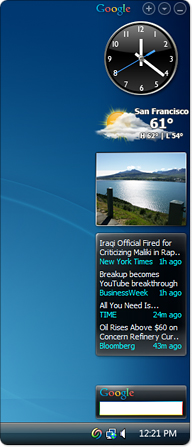Google Desktop

The GDS Sidebar sits on the user's desktop and displays relevant information (Google Desktop on Microsoft Windows Vista)
|
|
| Developer(s) | |
|---|---|
| Initial release | October 14, 2004 |
| Stable release |
5.9.1005.12335
|
| Development status | Discontinued September 14, 2011 (in operation for 7 years) |
| Written in | C++ |
| Operating system | Cross-platform |
| Type | Desktop search |
| License | Proprietary |
| Website | desktop.google.com |
Google Desktop was a computer program with desktop search capabilities, created by Google for Linux, Apple Mac OS X, and Microsoft Windows systems. It allowed text searches of a user's email messages, computer files, music, photos, chats, Web pages viewed, and the ability to display "Google Gadgets" on the user's desktop in a Sidebar.
In September 2011, Google announced it would discontinue a number of its products, including Google Desktop. The reason given was that "In the last few years, there’s been a huge shift from local to cloud-based storage and computing, as well as the integration of search and gadget functionality into most modern operating systems. People now have instant access to their data, whether online or offline. As this was the goal of Google Desktop, the product will be discontinued".
As of January 2008, Google Desktop featured the following functionality:
A prominent feature of the Google Desktop is the Sidebar, which holds several common Gadgets and resides off to one side of the desktop. The Sidebar is available on the Windows and Linux versions of Google Desktop. The Sidebar comes pre-installed with the following gadgets:
Like the Windows Taskbar, the Google Desktop sidebar can be set to Auto-Hide mode, where it will only appear once the user moves the mouse cursor towards the side where it resides. If not on auto-hide, by default the sidebar will always take up about 1/6 – 1/9 of the screen (depending on the screen resolution), and other windows are forced to resize. However, the sidebar can be resized to take less space, and users can disable the "always on top" feature in the options. With the auto-hide feature on, the sidebar temporarily overlaps maximized windows.
Another feature that comes with the Sidebar is alerts. When the Sidebar is minimized, new email and news can be displayed on a pop-up window above the Windows Taskbar.
When searching in the sidebar, deskbar or floating deskbar, Google Desktop displays a "Quick Find" window. This window is filled with six (by default) of the most relevant results from the user's computer. These results update as the user types, and allows use without having to open another browser window.
Deskbars are boxes which enable searching directly from the desktop. Web results will open in a browser window, and selected computer results will be displayed in the "Quick Find" box (see above). A Deskbar can either be a fixed deskbar, which sits in the Windows Taskbar, or a Floating Deskbar, which may be positioned anywhere on the desktop.
...
Wikipedia
